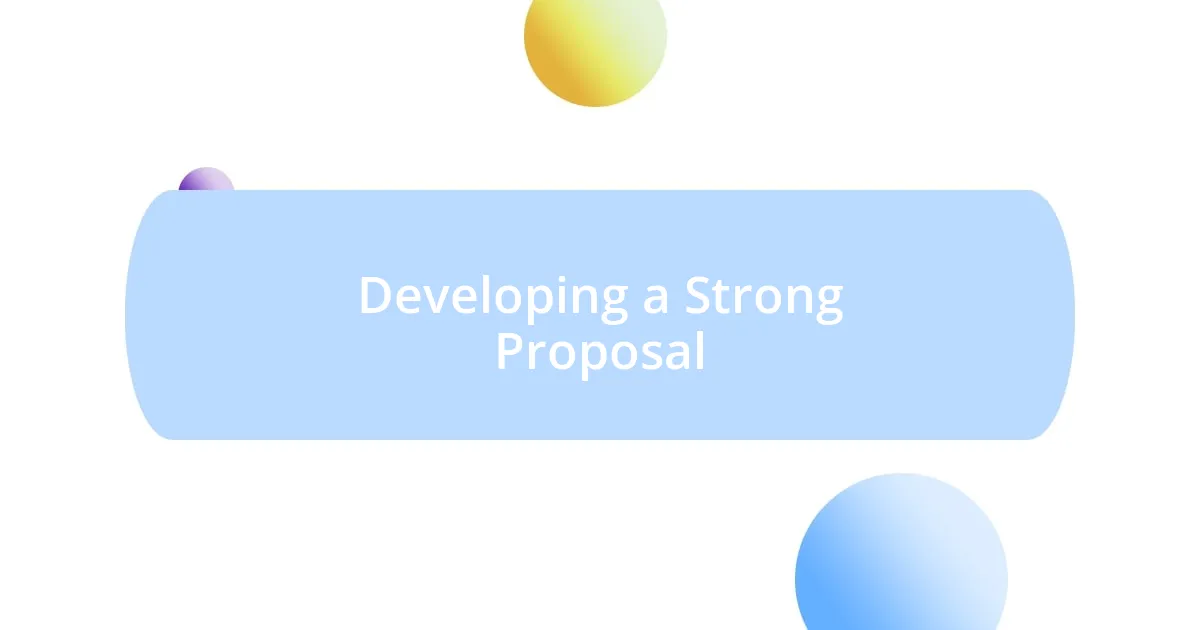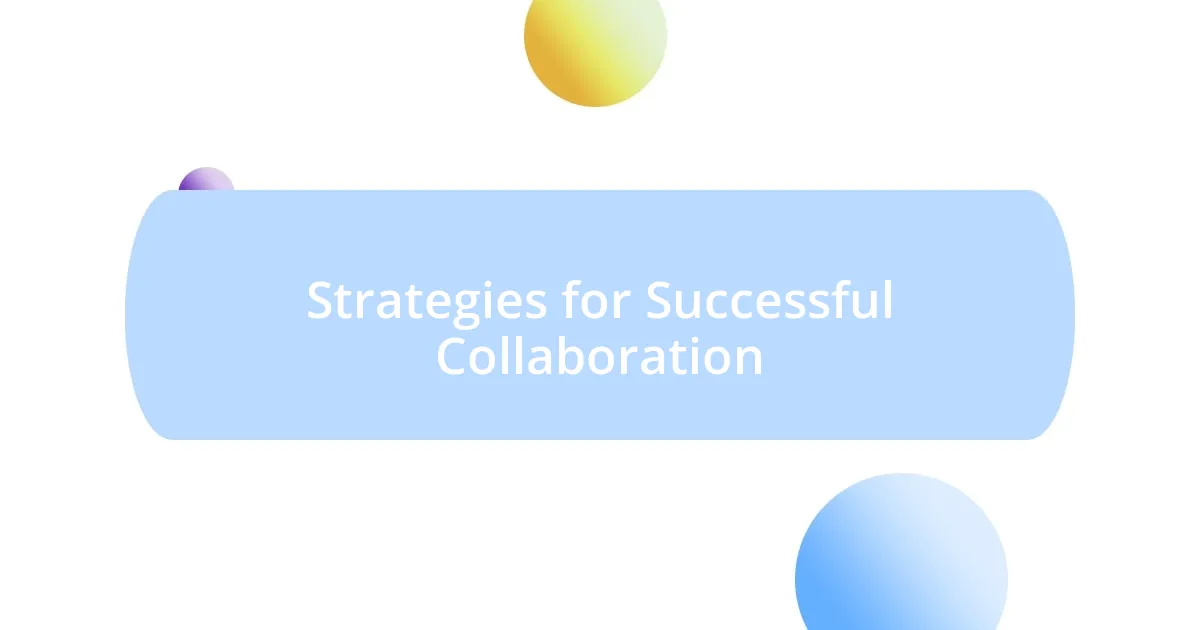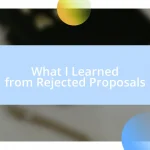Key takeaways:
- Collaboration in grant writing enhances proposal quality through diverse perspectives and shared expertise, fostering innovative solutions.
- Effective communication, including structured plans and open feedback, is essential for overcoming challenges and ensuring team cohesion.
- Clearly defining roles within the team, such as project manager and subject matter expert, contributes significantly to the project’s success.
- Establishing common goals and utilizing strengths of team members can empower individuals and drive productive collaboration.

Understanding Collaborative Grant Writing
Collaborative grant writing is a unique process that brings together individuals from diverse backgrounds to combine their expertise and perspectives. I remember my first experience with this type of writing; it felt like a puzzle where each piece represented a different area of knowledge, and that excitement of fitting them together was truly electrifying. Have you ever thought about how collective brainstorming can lead to ideas that might never surface in a solo effort?
In my experience, the synergy created through collaboration can enhance the quality of the proposal dramatically. I once worked with a team where one person had a strong background in data analysis, while another brought in a wealth of community insights. This blend allowed us to craft a narrative that was not only data-driven but also deeply connected to the community’s needs—something I’ve found is crucial for winning grants.
However, it’s not always smooth sailing; it can also introduce challenges, especially when navigating differing communication styles or conflicting ideas. I often ask myself how we can create a harmonious environment that fosters open dialogue. Finding common ground, sharing responsibilities, and engaging in respectful discussions can transform those challenges into stepping stones for a stronger proposal.

Benefits of Team Efforts
The benefits of teamwork in grant writing are numerous and can profoundly impact the final proposal. Reflecting on a project I was involved in, I realized how much richer our ideas became when everyone contributed their unique expertise. It’s fascinating when team members collectively share their experiences; this leads to creative solutions that often surpass individual efforts.
Here are some key benefits of team efforts in grant writing:
- Diverse Perspectives: Each team member brings a distinct viewpoint, enriching the proposal’s creativity and depth.
- Shared Workload: Collaborating helps to evenly distribute tasks, making the process less overwhelming and more efficient.
- Increased Accountability: Working closely with others fosters a sense of responsibility, motivating each member to produce high-quality content.
- Networking Opportunities: Team collaborations often create lasting professional relationships, opening doors for future projects and support.
- Enhanced Problem-Solving: The varied backgrounds and expertise mean that complex problems can be approached from multiple angles, leading to innovative solutions.
When I teamed up with a researcher who had a knack for storytelling, it was enlightening to witness how the narrative of our proposal transformed. The project felt lighter, more enjoyable, and ultimately, it reflected a collective effort that was greater than the sum of its parts.

Key Roles in Grant Writing
The roles in grant writing are pivotal to the project’s success, and understanding these roles can significantly enhance collaboration. For instance, I have found that a dedicated project manager is invaluable in keeping everyone aligned and on track. In one project, our manager was the glue that held our diverse team together, navigating communication barriers and ensuring deadlines were met. This experience taught me how important a facilitator can be, transforming chaos into organized flow.
Each role carries its own set of responsibilities and impacts the team’s dynamics. For example, having a subject matter expert on board is often a game-changer. Their insights can provide depth and credibility, as I discovered during a collaborative effort where a health expert guided our approach to community wellness. The knowledge they brought to the table made our proposal not just informative but truly enlightening, reflecting real-world applications.
Moreover, the writer or editor must translate the team’s ideas into a cohesive narrative. This role is crucial; their ability to weave together the collective thoughts into a compelling story can make all the difference. I remember a time when our editor reshaped our draft, turning a rough outline into a polished proposal that truly resonated with our audience. That experience reaffirmed my belief that every role is essential, and together, they create a more compelling case for funding.
| Role | Responsibility |
|---|---|
| Project Manager | Coordinates team efforts, manages timelines, and facilitates communication. |
| Subject Matter Expert | Provides specialized knowledge and insights relevant to the proposal. |
| Writer/Editor | Crafts the narrative, ensuring clarity and cohesion in the proposal. |

Developing a Strong Proposal
When I think about developing a strong proposal, what often stands out is the clarity of purpose. I’ve learned that an effective proposal clearly articulates its goals and objectives right from the start. In one project where we were looking to secure funding for educational resources, laying out our specific objectives early on gave the reviewers a clear roadmap of what to expect. It made all the difference in conveying our commitment and vision, leading to a much more compelling argument for our cause.
Another critical element is the inclusion of solid data to back our claims. Reflecting on a previous project, we incorporated testimonials and statistics that highlighted community needs, which helped ground our proposal in reality. It not only lent credibility to our arguments but also appealed to the emotional aspect of our narrative. Isn’t it fascinating how people are more likely to invest in ideas that resonate emotionally and are supported by hard facts?
Finally, I believe that engaging storytelling is essential in proposal writing. I recall a time when we included a heartfelt story about an individual impacted by our project. This narrative not only humanized our proposal but also created a connection with the reviewers. They could envision the real-world implications of our work, stirring their interest and empathy. Remember, a proposal is not just a solicitation for funding—it’s an invitation to join in a transformative journey. How can we ensure that our story inspires them to see the value in supporting our mission?

Effective Communication Among Grant Writers
Effective communication among grant writers is the foundation of a successful collaborative effort. I remember one project where we faced unexpected setbacks because communication was lacking. Our team met regularly, yet the conversations often became fragmented. When we implemented a structured communication plan, including weekly check-ins and a shared document for ongoing updates, everything changed. We started to feel more connected, and suddenly, ideas flowed more freely.
In another experience, I saw firsthand how fostering a culture of open feedback can enhance collaboration. During a proposal development phase, we created a safe space for sharing thoughts, questions, and constructive criticism. I vividly recall one member who shared a draft that sparked a lively discussion. Through this exchange, not only did we refine our proposal, but we also deepened our relationships, learning to trust and rely on each other’s insights. Isn’t it amazing how a simple change in approach can transform a team dynamic?
Moreover, using technology can bridge communication gaps as well. I advocate for tools like shared project management platforms where everyone can see updates in real time. For example, in one collaborative effort, we used Trello to track our tasks and ideas. This visual tool allowed us to feel our progress, make adjustments on the fly, and prioritize effectively. This experience truly taught me that effective communication is not just about talking; it’s about creating a space where everyone feels heard and valued, driving us closer to our collective goal.

Strategies for Successful Collaboration
Collaboration is a dance that requires rhythm and intention. One strategy I find invaluable is establishing common goals from the very beginning. During one grant writing initiative, our team held a brainstorming session focused solely on aligning our vision. It was eye-opening! As we shared our individual perspectives, we discovered common threads that unified our purpose. This clarity built trust among us and galvanized our collective effort toward a shared outcome.
I’ve also learned that distributing roles based on team members’ strengths fosters a sense of ownership and accountability. In a past project, we mapped out each person’s skills and interests, assigning tasks accordingly. I was amazed at the transformation—everyone stepped up, fully invested in their responsibilities. It became clear how empowering individuals can lead to a more cohesive and productive team. How often do we overlook the power of strengths in achieving successful collaboration?
Finally, creating a feedback loop is essential for continuous improvement. I remember a project where we dedicated time at the end of each week to reflect on what worked and what didn’t. This simple practice not only improved our proposal but also cultivated a supportive atmosphere where everyone felt their input mattered. It’s fascinating to consider that constructive criticism is, in fact, a stepping stone to success. How can we embrace feedback as a vital part of our collaborative journey?

Managing Challenges in Team Writing
Managing challenges in team writing can feel overwhelming at times, but I believe that openness is key. I vividly recall an instance where our team faced a conflict over differing visions for the grant’s focus. Instead of letting it fester, we set aside a dedicated session to air our concerns. That dialogue not only clarified our direction but also deepened our respect for each other’s perspectives. Isn’t it fascinating how addressing conflict head-on can transform tension into collaboration?
One issue I often see arising is the inconsistency in writing styles, which can dilute a proposal’s voice. In one of my past projects, we created a shared style guide that included key terminology and formatting preferences. This simple document served as our writing beacon. As we wrote and edited, we found ourselves referring back to it constantly, which kept our proposal cohesive. If you’ve ever struggled with different voices in a single document, you know how crucial this kind of alignment can be.
Time management is another hurdle that teams often encounter. I’ve been part of projects where deadlines loomed, and panic set in. To combat this, we implemented mini-deadlines for sections of our proposal. This approach not only kept us on track but also made the process feel less daunting. It was exhilarating to check off tasks step by step, and I could see that everyone felt a sense of accomplishment along the way. How do you tackle time management when working as a team?














